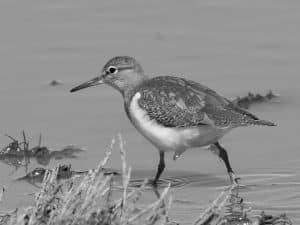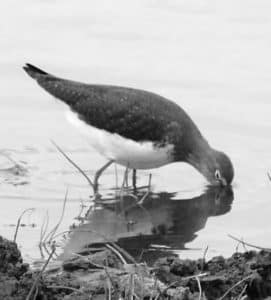Introduction to the Common Sandpiper
The common sandpiper in Tanzania, also known as Actitis hypoleucos, is a small migratory bird that belongs to the family Scolopacidae. They measure approximately 7-8 inches in length and have a wingspan of 15-16 inches. Their plumage is a mix of brown, white, and gray feathers, with a distinctive white belly and a long, slender beak.
Habitat and Distribution of the Common Sandpiper in Tanzania

Common sandpipers are found in a variety of habitats, including freshwater wetlands, rivers, lakes, and coastal areas. In Tanzania, they can be spotted along the shores of Lake Victoria, Lake Tanganyika, and the Rufiji River. They are also found in the Selous Game Reserve and other protected areas throughout the country.
Physical Characteristics of the Common Sandpiper
The common sandpiper has a unique physical appearance that sets it apart from other bird species. Their slender beak is adapted for probing in the mud and sand for insects and small crustaceans. They have a distinctive teetering gait that is often described as “bobbing.” This bobbing motion is a result of their habit of pumping their tail up and down while walking.
Behavior and Mating Habits of the Common Sandpiper
Common sandpipers are solitary birds that are often seen alone or in pairs. During the breeding season, they perform a courtship dance that involves the male flying in wide circles around the female while calling out. The female will then respond with a series of calls and they will mate. The female will lay 3-4 eggs in a shallow nest on the ground, which both parents will take turns incubating.
Conservation Status of the Common Sandpiper in Tanzania

The common sandpiper is listed as a species of “least concern” by the International Union for Conservation of Nature (IUCN). However, their populations are declining due to habitat loss and degradation. In Tanzania, their habitats are threatened by deforestation, pollution, and overfishing. Conservation efforts are focused on protecting their wetland habitats and promoting sustainable fishing practices.
Best Places to Spot Common Sandpipers in Tanzania
If you want to spot common sandpipers in Tanzania, head to the shores of Lake Victoria, Lake Tanganyika, or the Rufiji River. The Selous Game Reserve is also a good place to see them. Look for them along the shoreline or wading in shallow water.
Birdwatching Tips for Observing Common Sandpipers
To make the most of your birdwatching experience, bring a pair of binoculars or a spotting scope. Common sandpipers are often seen feeding along the shoreline, so be patient and observant. They can be difficult to spot due to their small size and camouflaged plumage. Listen for their high-pitched calls, which can help you locate them.
Interesting Facts about the Common Sandpiper

- Common sandpipers are known for their long-distance migrations. They breed in Europe and Asia and spend the winter in Africa, Asia, and Australia.
- They have a unique way of foraging that involves running along the shoreline while pecking at the ground.
- The common sandpiper is sometimes called the “summer snipe” due to its resemblance to the snipe.
Other Bird Species Found in the Same Habitat as the Common Sandpiper
If you’re interested in birdwatching in Tanzania, there are many other species to discover in addition to the common sandpiper. Look for African fish eagles, pied kingfishers, and malachite kingfishers along the rivers and lakeshores. In the wetlands, you may spot African jacanas, black crakes, and papyrus canaries.
Conclusion: Appreciating the Charisma of Common Sandpipers in Tanzania
In conclusion, the common sandpiper may be small, but it is a bird with big charisma. Its unique physical appearance, behavior, and charm make it a joy to watch. By visiting the shores of Lake Victoria, Lake Tanganyika, or the Rufiji River in Tanzania, you can observe these delightful birds in their natural habitat. Remember to take your time, be patient, and bring your binoculars for the best birdwatching experience.

































